Off-road vehicle four-wheel drive systems explained
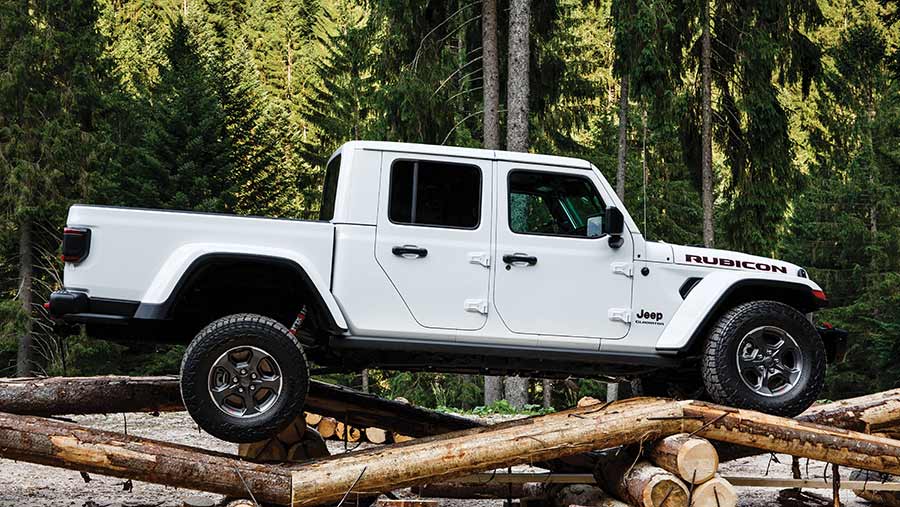 Jeep Gladiator
Jeep Gladiator Flick through the marketing bumf for a new four-wheel-drive vehicle and it will generally give little indication as to the type of off-road running gear in place.
There are plenty of terms such as Intelligent AWD, 4Matic, Super Select II and Quattro bandied about, but clues to the mechanical hardware are often hard to find. The fact that some makers use the same brand name for a number of different systems also adds to the confusion.
In a bid to discover what is actually going on under the bodywork, we’ve taken an in-depth look at the main four-wheel drive systems that manufacturers use, and pinned down what they can and, crucially, can’t do.
These essentially break down into three categories: part-time four-wheel drive, permanent four-wheel drive (sometimes referred to as all-wheel drive) and automatic four-wheel drive. However, there are a number of different approaches to each of these setups.
Hybrid vehicles add another dimension, where an electric motor powers the rear axle in many four-wheel-drive versions, while some fully electric vehicles use a motor on each wheel. But we’ll deal with these another time.
The basics of four-wheel drive
In order to turn corners effectively, cars must have differentials on each axle that allow left and right wheels to turn at different speeds.
Vehicles that are designed to travel on high-traction surfaces (such as roads) in four-wheel drive also have to add some form of central differential into the mix to account for the speed differences between the front and rear axles.
However, with all of these differentials open, no wheel is capable of receiving more torque than another. Therefore, if one wheel starts to spin, the rest of the wheels receive the same amount of torque, which isn’t sufficient to get the vehicle moving.
This is where manufacturers’ various combinations of diff-locks, viscous couplings, traction control and torque-vectoring systems come in, attempting to make sure as much torque gets to the wheels that have grip without compromising the driving characteristics.
1. Part-time four-wheel drive
Part-time four-wheel-drive systems are arguably the most basic way of getting drive to all four wheels, and these setups are still used in most pickup trucks.
Vehicles falling into this category have a two-range transfer box fitted between the transmission and axles, which has two functions: to switch between a high and low range of gears and select two- or four-wheel drive.
Two-wheel drive sends all power to the rear wheels, and when four-wheel drive is activated, the transfer box sends power to the front propshaft via a heavy-duty chain. At the same time, freewheeling hubs on the front axle are automatically engaged and disengaged when switching back to two-wheel drive.
This reduces wear when driving on the road and improves the efficiency of the driveline. Traditionally, these hubs were activated by hand, and some semi-automated versions were introduced before the switch to fully automatic.
Crucially, vehicles with this setup don’t have a centre differential, which means they can’t be driven on the road in four-wheel drive. When four-wheel drive is selected, there is a fixed 50/50 torque split between front and rear, which won’t allow for any speed differential between the front and rear wheels.
If the system is engaged on surfaces that aren’t loose enough for the tyres to scrabble, it’ll cause wind-up in the transmission that can eventually break something.
This is where Mitsubishi steals a march with its higher-spec L200 models. By adding a torque-sensing Torsen centre differential, the Japanese maker has given drivers the option of using four-wheel drive on the road, which improves handling and reduces the chance of spinning the rear wheels. This can also be locked manually, giving an equal front/rear torque split for more challenging conditions.
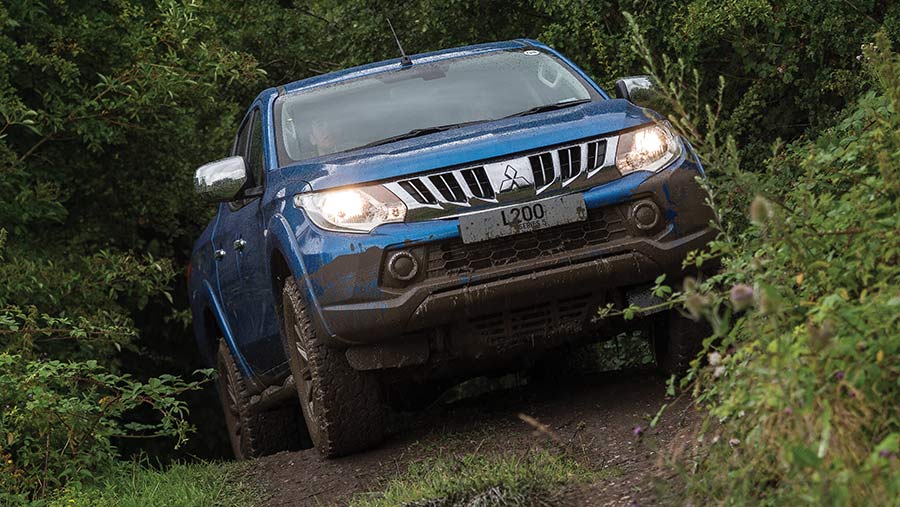
Mitsubishi L200
The same system is used on the Shogun Sport and it was used on the full-size Shogun before it was discontinued in the UK.
Some vehicles have achieved a similar effect with an auto mode that uses a wet clutch in the transfer case to direct drive to the front wheels when required. Nissan used this on some Pathfinder models.
As for axle differentials, some part-time four-wheel-drive vehicles come with open diffs front and rear and rely solely on the traction control system to pulse the brakes on spinning wheels to transfer a bit more torque to those with grip.
However, many pickup trucks will have a manual locking rear differential to give extra assistance in particularly tough conditions.
As far as we know, no pickups currently on sale in the UK offer a manual front diff-lock. But that will change when Jeep’s Gladiator pickup arrives in the UK later this year.
It is based on the Wrangler, and in the top Rubicon spec it will have twin Dana 44 axles with manual diff-locks. It also has a feature that can remotely unlock the front sway bar for greater axle articulation.
Vehicles running a part-time 4×4 system include:
- Most pickup trucks
- Suzuki Jimny
- Jeep Wrangler and Gladiator
- Mitsubishi Shogun and Shogun Sport
2. Permanent 4×4
High and low range
Vehicles fitted with a centre differential and no option of running in two-wheel drive are generally referred to as permanent 4x4s, and if they’re serious about going off road, they will have a two-range transfer box too.
Well-known examples featuring this setup are the old Land Rover Defender and the current Toyota Land Cruiser. Both have a transfer box that includes a central differential, but they lack the planetary gearset that allows them to be operated in two-wheel drive on the road.
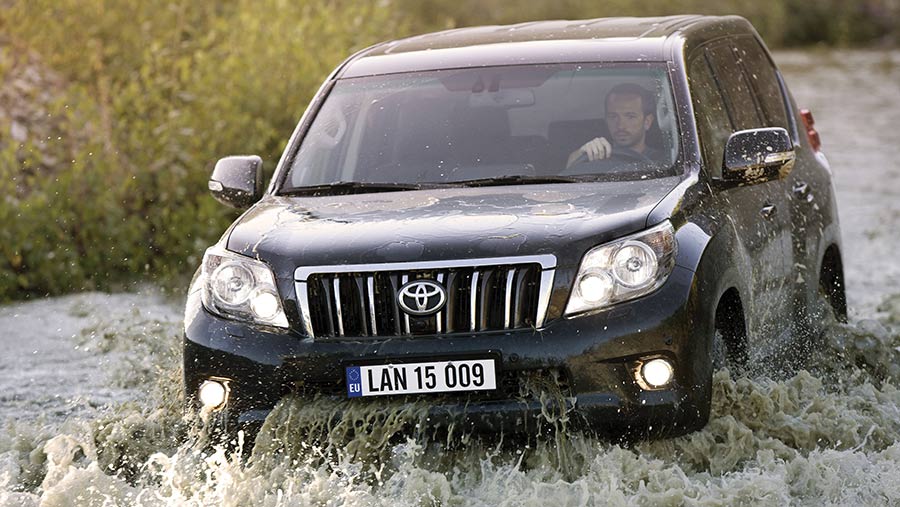
This simplifies the drivetrain and the only real downsides are poorer fuel consumption and more moving parts to maintain.
As for the Defender, this came out of the factory with a lockable centre differential in the transfer case, allowing a 50/50 torque split between front and rear when required.
Both axles have open differentials, so it is possible to get stuck if a front and rear wheel don’t have traction. Impressive axle articulation helps compensate for this in certain conditions, but some serious off-roaders fit aftermarket axle diff-locks.
Early Discovery models used the same setup, but over the years, there has been a migration to more electronic aids.
The most recent Defender and Discovery models still have a central diff, plus the option of low range and a locking rear diff. However, these are fancy electronic units that will operate automatically to hunt around for grip.
Toyota’s Land Cruiser is a little more traditional, but still layered with electronics. It has a Torsen torque-sensing centre differential, which in normal conditions distributes torque evenly between the axles. If it senses slip, it can send up to 70% to the front or rear, but drivers can manually lock it to maintain 50/50 torque distribution.
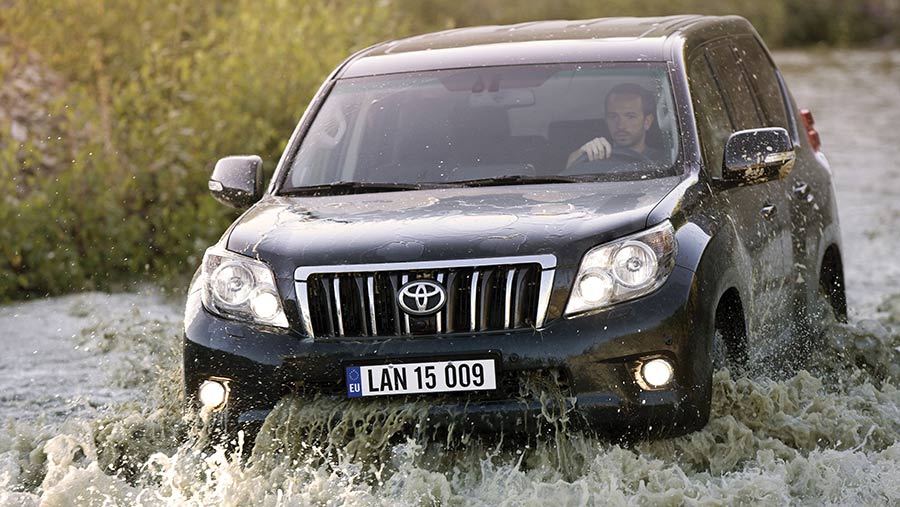
Toyota Land Cruiser
At the rear, buyers get to choose whether they have an open, torque-sensing Torsen or limited-slip diff, but the front is always open. Like most other modern off-road vehicles, this is mated to a traction control system.
The only off-road vehicle we’re aware of that adds a manual-locking front differential to a permanent 4×4 system is Mercedes’ G-Class (formerly the G-Wagon).
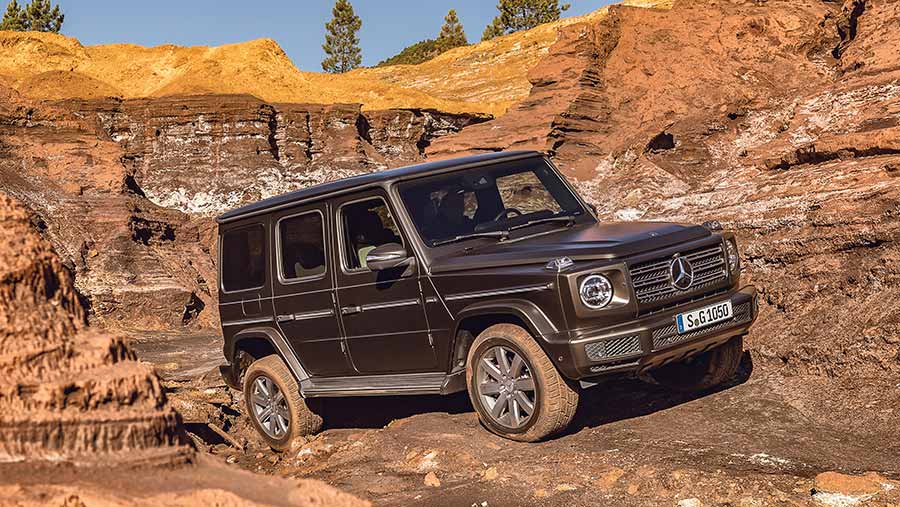
Mercedes G-Class
It’s a very expensive, niche vehicle these days, but it gives drivers all the mechanical off-road options straight out of the dealership. It has a high-low transfer box with lockable centre differential, as well as manual lockers on the front and rear axle.
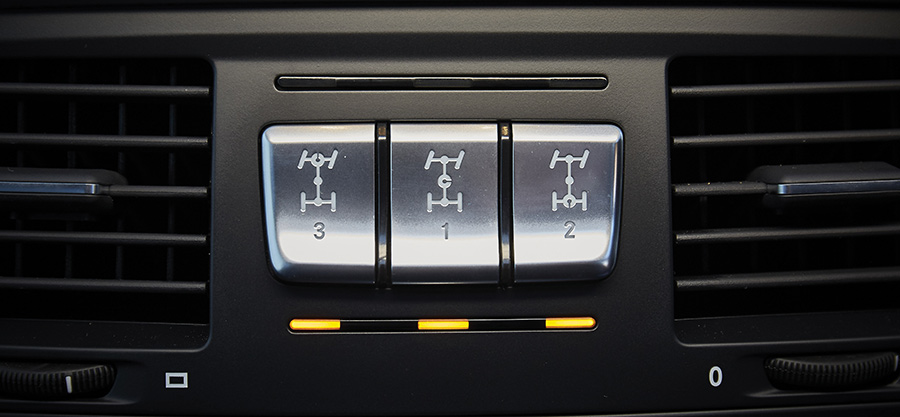
Mercedes G-Class diff-locks
Vehicles running a two-range permanent four-wheel drive system include:
- Land Rover Defender, some Discovery and Range Rover models
- Current Toyota Land Cruiser
- Some Volkswagen Touareg models (not current range)
- Mercedes G-Wagon
Single-range permanent four-wheel drive
Many large SUVs run a permanent four-wheel-drive system with a single-range transmission.
Although they have enough off-road ability for most buyers, the lack of a torque-multiplying low gear range means they’re generally more focused on road performance.
There are some examples that manage to perform very well off-road, thanks partly to electronic systems such as hill-descent control that allow them to drive down steep slopes in a restrained manner.
The only UK pickup model to feature a permanent four-wheel-drive system is VW’s Amarok with automatic transmission.
These trucks are fitted with an eight-speed ZF ‘box and have a Torsen limited-slip central diff to distribute power to the front and rear axles.

VW Amarok
In normal running, this is set to deliver 40% of torque to the front axle and 60% to the rear, but the Torsen diff alters this according to the amount of grip available. It’s fully automated, with no manual lock function.
In standard spec, the front and rear axle diffs are open and the traction control system helps transfer torque to the wheels with grip. However, there is the option to specify a manual-locking rear differential.

VW Amarok drivetrain
Torsen centre differentials are now fairly commonplace in this type of drivetrain, but Subaru is one example that still uses a viscous coupling. These are only fitted in manual models, though, and CVTs have an automatic multi-plate clutch setup.
Vehicles running a single-range permanent four-wheel drive system include:
- VW Amarok automatic
- Audi Q5, Q7 and Quattro cars apart from A3, S3 and TT
- Most VW Touareg models
- Some Land Rover Discovery models
- Manual Subaru Forester
3. Automatic 4×4
The boom in in the number of four-wheel-drive vehicles on the road has been fuelled largely by the success of the compact SUV.
These vehicles typically have a transverse four-cylinder engine (most large 4x4s have longitudinal engines) with the transmission slung underneath, making them similar in configuration to a hatchback.
It would be difficult and expensive to fit these cars with traditional full-time four-wheel-drive running gear, so instead they use an automatic system that sends drive to the rear wheels when it is required.
Thanks to modern sensors and clever electronics, they can give surprisingly good performance, but they’re no match for a proper mechanical setup when the going gets tough.
Typically, these systems have a power transfer unit (PTU) bolted to the front transaxle, which turns the driveline 90deg before a propshaft sends the power to the rear.
In many cases, the propshaft spins constantly and some sort of computer-controlled multiplate clutch attached to (or integrated into) the rear diff connects the drive when it’s required.
There are a number of different types, but the Haldex unit (now owned by Borg Warner) is probably the best known. It uses a hydraulic pump to engage and disengage and early examples relied on front wheel slip to connect the drive.
Later versions are more proactive, using data from various sensors (such as ABS throttle and selected drive mode) to make a decision on when to kick in.
The system can be tailored to suit different manufacturers’ needs and can be set to send a certain proportion of drive to the rear at all times, if required.
Another brand offering this type of transmission is GKN. Its Twinster clutch unit has the ability to shuffle power between the front and back of the vehicle on demand, and between the rear wheels without relying on the ABS system. This is known as torque vectoring.
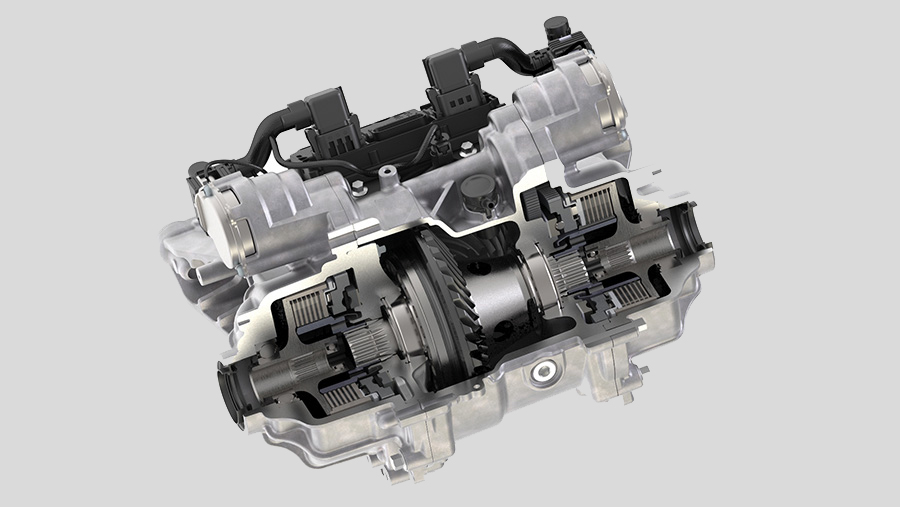
Land Rover GKN Twinster
The system is used in some Discovery Sport models and Range Rover Evoque models built after 2014. GKN also builds simpler units, one of which is used by Dacia in the Duster.
Vehicles running an automatic four-wheel-drive system include:
Haldex
- VW Tiguan
- Audi Q3
- Volvo V70 Cross Country, XC70 and XC90
- Ford Kuga
- Land Rover Freelander (earlier models had a viscous coupling) Discovery Sport and Range Rover Evoque (up to 2013)
- Skoda Octavia 4×4
- VW Passat
- VW Golf and Audi A3
- BMW X1
GKN
- Dacia Duster
- Nissan Qashqai and X-Trail
- Mini Countryman
- Audi RSQ3
- Volvo XC90
- Some Land Rover Discovery Sport and Evoque models built from 2014
Off-road jargon buster
Limited-slip differential
This is a catch-all term for differentials that have the ability to progressively lock depending on how much wheel slip is occurring. This means they can operate without any driver input, but they can’t freeze the differential solid like manual locks can.
Torsen differential
Torsen torque-sensing differentials use a clever combination of worm and spur gears that allow them to lock and transfer torque when wheels start to spin. Their ability to lock and unlock on demand – without any driver or electronic input – makes them a popular choice as a central differential. They’re famously used in Audi Quattro models and many off-road vehicles that can operate in four-wheel drive on the road.
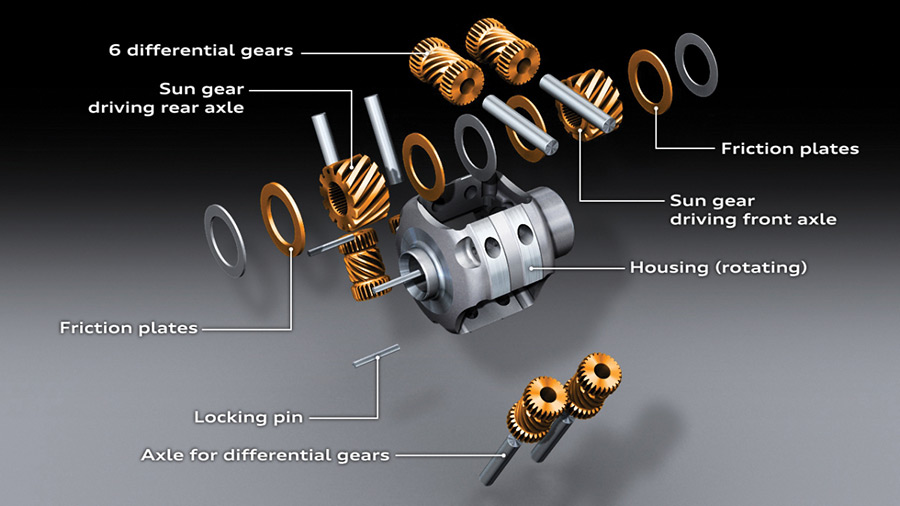
Torsen differential
Viscous coupling
Viscous couplings are a simple and cost-effective alternative to a centre differential. They sit between the front and rear driveshafts and have a series of metal plates immersed in fluid. When the front and rear driveshafts spin at the same speed, this fluid is viscous, but if one shaft starts to spin faster than the other, this turns to a solid and locks them together.
Traction control
Almost all modern cars are fitted with some form of computer-controlled traction control system that uses information from various sensors around the car to help it maintain grip. For off-road driving, it uses the car’s ABS system to rapidly brake spinning wheels so that torque is transferred to those with grip. For vehicles that don’t have limited-slip or locking differentials, it helps achieve similar results. When it’s working, drivers can hear and feel the ABS clicking in and out as the brakes are pulsed on different wheels. Manufacturers use various different names for this, such as electronic limited slip differential (ELSD).
Hill descent control
This is a system that automatically controls a vehicle’s speed when descending steep slopes. It’s essentially an extension to the traction control system and works by using the ABS brakes to maintain a consistent speed. It was developed to help improve the performance of vehicles without a low-range transmission, but it is now a fairly common feature on all off-roaders.
Torque vectoring
In simple terms, torque vectoring is the process of sending engine torque to the wheels that need it most. Unlike traction control systems that use the brakes to do this, proper torque-vectoring systems have electronically activated limited-slip differentials. They work faster and more effectively, so are usually found on higher-performance models.

